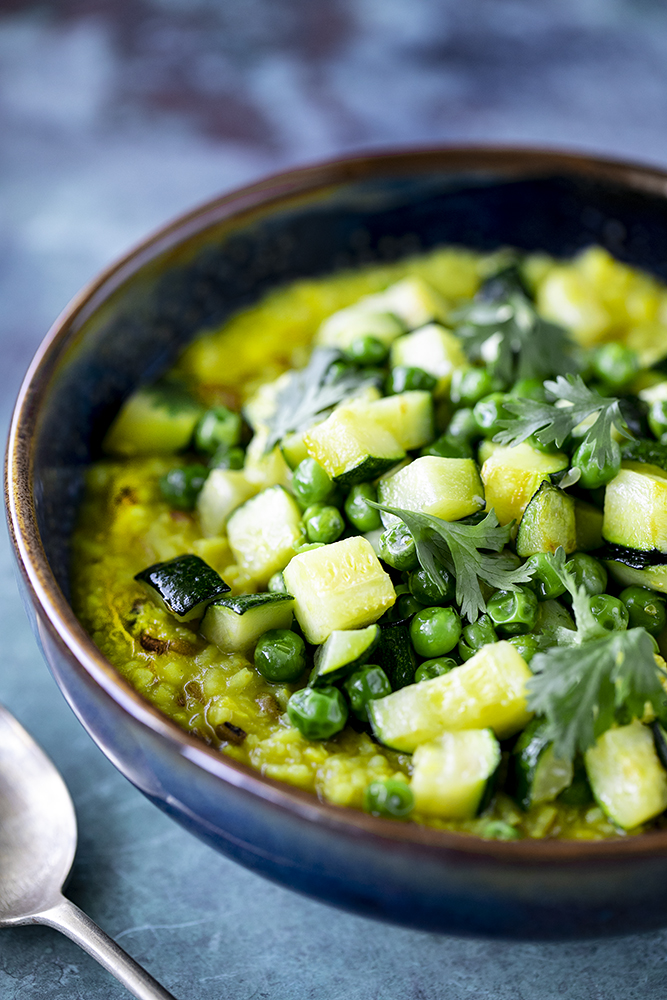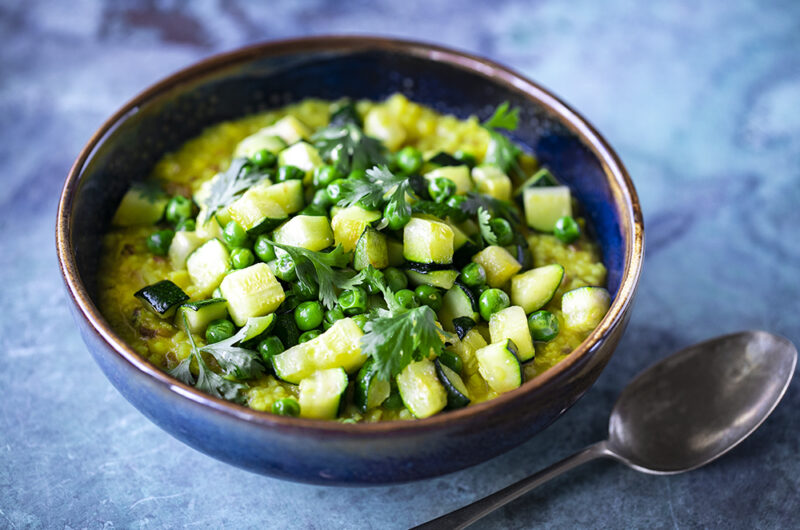
Kitchari is a one-pot dish made from white basmati rice, yellow split mung beans, ghee butter, vegetables and digestive spices that are traditionally used in Ayurveda to balance the digestion and gently detoxify, whilst nourishing all the tissues of your body.
Kitchari is also known as an incredibly healing Ayurvedic food, calming your nervous system and rebalancing your entire mind-body system.
This easily digestible meal gives your body a break to restore the natural strength of agni, the digestive fire.
Seasonal transition is always a delicate time of year for our bodies because we are experiencing a very powerful shift. These changes are reflected in our bodies as well, you may experience dry skin and joints, increased anxiety, or digestive issues. Kitchari is a perfect meal for this part of the year. It’s a light, easy-to-digest, cleansing, detoxifying, nourishing food that is excellent once a week, or as 5-day detox program.
Traditionally, kitchari is an important part of the healing process of Panchakarma. Panchakarma is one of the most well-known treatments of Ayurveda. It is a five-step, total mind-body rejuvenation experience that comprises of herbal oil massages, steam baths, cleansing enemas, a healing kitchari diet and other purifying practices.
While kitchari looks like an ordinary savoury porridge, however, this dish is a whole science, where each ingredient has its purpose. Below you will find a description of the main ingredients and their purpose in this dish:
- Rice and beans is a cultural icon in many parts of the world. It’s pretty healthy and relatively cheap. Rice and legumes have a symbiotic relationship in which the amino acids of each complement one another to form a complete protein, which is the foundation for the growth and development in humans.
- Basmati rice. Basmati rice is lighter than other types of rice, it makes this type of rice very special. Basmati rice has a low content of starch and accordingly low GI, lower than for other types of rice. The glycemic index is a measure of how your body handles sugar. Basmati rice GI is 52 making it a low-glycemic food (White rice has a glycemic index of 79, which makes it a high-glycemic-index food. Brown rice has a glycemic index of 55). Brown basmati is heartier and more warming than white basmati, but more difficult to digest.
Don’t forget to prepare basmati rice properly, wash it a few times, removing excess of starch until the water is clear. Soak for about 30 minutes if you have time. - Split mung beans. Mung beans are a great source of protein, fibre, iron, and other nutrients, so they’ re a perfect detox food. Mung beans are the easiest legumes for digestion, however, it may cause discomfort if you do not eat legumes on a regular basis. Basmati rice and spices using for kitchari such as fennel, turmeric, ginger and cumin known to enhance digestion and decrease gas in the gut. Soaking the mung beans before cooking also can help for digestion. Bonus- soaking beans reduces cooking time! I could also recommend to add some probiotics to your meal, serve kitchari with a little probiotic coconut yoghurt for the best result.
- Ghee butter. Ghee, or Indian-style clarified butter, is a common Ayurvedic Kitchen staple. It plays a fundamental role in keeping agni – digestive fire and highly recommended for poor digestion. Ghee is believed to assist with digestion by allowing food to be broken down more efficiently, by stimulating digestive enzymes. Ghee is also known for its anti-inflammatory properties and ability lubricates the connective tissues, that makes it a favourite of yoga practitioners.
- Spices used for kitchari. The spices and ginger help give your digestive system a much-needed break and will produce balancing effects for the three bodily doshas. Use 4 or fewer spices that suitable to your dosha and see how it feels.
Kitchari spice mix usually includes the following spices:
- Turmeric for supporting the digestion (and associated organs like the pancreas) and the elimination of natural toxins from the gastrointestinal tract.
- Mustard seeds. They have a heating quality that will kindle your digestive fire (agni) and help with occasional bloating and digestive discomfort.
- Cumin seeds. Not only does it support digestion, but it has a taste that will stimulate a healthy appetite.
- Ginger. It’ s known as the “universal medicine” for its broad range of benefits. It is warming, promotes digestion, supports healthy circulation.
- Asafoetida. It helps with occasional bloating, gas, and stagnation in the gastrointestinal tract. This herb will also remove natural toxins from the digestive tract.
- Coriander seeds. It is good for digestion, stimulates the appetite, supports a healthy response to allergens and also helps purify the blood.
6. Vegetables and aromatics. Avoid rajasic and tamasic vegetables, spicy and heavy ingredients in kitchari such as onion, garlic, chili pepper, tomato and potato. They are irritants and stimulants. Choose your favourite vegetables that you feel good and comfortable with, any vegetables that suit your dosha: carrots, green peas, beetroot, zucchini, green beans, green leafy vegetables, fennel, parsnip, kumara and corn. The vegetables have to be fully cooked, it makes them easy to digest.
7. Mineral salt. Himalayan salt is an excellent source of minerals and trace elements. Pink Himalayan salt boasts over 84 minerals and other elements, such as iron, magnesium, calcium, and potassium. These minerals give it a pink colour. Make sure you use genuine Himalayan salt from a specialized shop, not from a common supermarket. I would also recommend checking the list of minerals on the package.
Tap water in some parts of New Zealand (in Auckland where I live) is comparatively low in the minerals and salts that make the water soft. Deficiency of minerals in drinking water can cause health problems such as hair loss, weak bones, fatigue, or a decreased immune system.
8. Cook fresh every day. Do not make a big batch for the week and then freeze it. Frozen food and leftovers have little prana ( energy) to offer your body, increasing your prana is the key to true health.
Kitchari. Ayurvedic Healing and Nourishing Porridge.
Course: Main, Detox food, Lunch, DinnerCuisine: Indian, Detox foodDifficulty: Easy4-6
servings2
hours30
minutesKitchari is a one-pot dish made from white basmati rice, yellow split mung beans, ghee butter, vegetables and digestive spices that are traditionally used in Ayurveda to balance the digestion and gently detoxify, whilst nourishing all the tissues of the body.
Ingredients
1/2 cup basmati rice, washed and drained
1 cup split mung beans, soaked for a few hours
1 Tbs grated ginger
1/2 teaspoon fennel seeds
1/2 teaspoon cumin seeds
1 teaspoon coriander seeds
1 teaspoon turmeric powder
1/2 teaspoon mustard seeds
2 Tbs ghee butter
pinch of asafoetida (optional)
mineral salt such as Himalayan salt (Make sure you use genuine Himalayan salt)
1-2 cups chopped vegetables (I use zucchini and green peas)
- To serve:
fresh coriander leaves
coconut yoghurt (optional)
Directions
- Grind fresh whole spices in a mortar using a pestle. Preheat a saucepan, add one tablespoon of ghee butter. When it’s melted, add ground spices, fry swirling the skillet, for about 1 minute, or until it’s fragrant. Don’t overcook the spices, otherwise, they can turn bitter. Add ginger, turmeric and asafoetida, fry for another minute. Add washed rice and presoaked split mung beans, stir together for a few minutes. Add 6 cups of water and simmer for about 30 minutes in a covered pot, stirring occasionally. Add more water, as needed for desired thickness. I usually prefer a soupy consistency which is perfectly suitable for my dosha. Season kitchari with mineral salt.
- Preheat saute pan with one tablespoon of ghee. Add chopped vegetables and a pinch of salt (to prevent sticking and browning) and saute on medium-low heat until vegetables are soft and fully cooked. Season with mineral salt up to your desire.
- Divide kitchari between bowls, top with a dollop of sauteed vegetables. Garnish with fresh coriander leaves. Serve warm.



